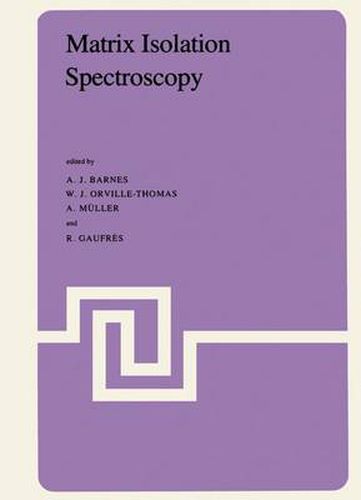Readings Newsletter
Become a Readings Member to make your shopping experience even easier.
Sign in or sign up for free!
You’re not far away from qualifying for FREE standard shipping within Australia
You’ve qualified for FREE standard shipping within Australia
The cart is loading…






This title is printed to order. This book may have been self-published. If so, we cannot guarantee the quality of the content. In the main most books will have gone through the editing process however some may not. We therefore suggest that you be aware of this before ordering this book. If in doubt check either the author or publisher’s details as we are unable to accept any returns unless they are faulty. Please contact us if you have any questions.
The matrix isolation (MI) method has now been used for nearly thirty years. During this period it has been actively developed and the range of problems tackled greatly extended. Originally it was used for studies of transient species involv ing vibrational, electronic and ESR spectroscopy. Nowadays the study of transient species forms a comparatively small part of HI work since it has been amply demonstrated that very fruitful information can be obtained of the structure and interactions of stable molecules and their aggregates. In addition to the s~ectroscopic methods mentioned above the MI technique is nowadays a standard method in research based on vibrational relaxation, luminescence, Mossbauer, magnetic circular dichroism, pulsed NMR and photoelectron spectroscopy. The matrix isolation technique affords considerable advantages over more conventional methods in most applications of spectroscopy. Areas where the technique has been widely applied, or shows great potential, include: metal atom chemistry, and its relation to surface chemistry, high temperature inorganic species, transition metal complexes, interstellar species, free radicals and unstable molecules, conformational studies, molecular com plexes, and intermolecular forces.
$9.00 standard shipping within Australia
FREE standard shipping within Australia for orders over $100.00
Express & International shipping calculated at checkout
This title is printed to order. This book may have been self-published. If so, we cannot guarantee the quality of the content. In the main most books will have gone through the editing process however some may not. We therefore suggest that you be aware of this before ordering this book. If in doubt check either the author or publisher’s details as we are unable to accept any returns unless they are faulty. Please contact us if you have any questions.
The matrix isolation (MI) method has now been used for nearly thirty years. During this period it has been actively developed and the range of problems tackled greatly extended. Originally it was used for studies of transient species involv ing vibrational, electronic and ESR spectroscopy. Nowadays the study of transient species forms a comparatively small part of HI work since it has been amply demonstrated that very fruitful information can be obtained of the structure and interactions of stable molecules and their aggregates. In addition to the s~ectroscopic methods mentioned above the MI technique is nowadays a standard method in research based on vibrational relaxation, luminescence, Mossbauer, magnetic circular dichroism, pulsed NMR and photoelectron spectroscopy. The matrix isolation technique affords considerable advantages over more conventional methods in most applications of spectroscopy. Areas where the technique has been widely applied, or shows great potential, include: metal atom chemistry, and its relation to surface chemistry, high temperature inorganic species, transition metal complexes, interstellar species, free radicals and unstable molecules, conformational studies, molecular com plexes, and intermolecular forces.